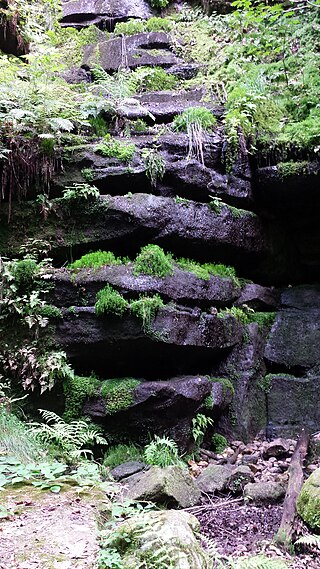
Tipularia discolor, the crippled cranefly or crane-fly orchid, is a perennial terrestrial woodland orchid, a member of the family Orchidaceae. It is the only species of the genus Tipularia found in North America. It occurs in the southeastern United States from Texas to Florida, the range extending north into the Ohio Valley and along the Appalachians as far north as the Catskills. There are also isolated populations in Massachusetts and in the Great Lakes region.

Cardamine concatenata, the cutleaved toothwort, crow's toes, pepper root or purple-flowered toothwort, is a flowering plant in the family Brassicaceae. It is a perennial woodland wildflower native to eastern North America.

Alisma gramineum is a small aquatic plant in the water-plantain family. It has several common names including narrowleaf water-plantain, ribbonleaf water-plantain or ribbon-leaved water-plantain, and grass-leaved water-plantain. It grows in mud or submerged in shallow fresh or brackish water in marshy areas.

Butomus is the only known genus in the plant family Butomaceae, native to Europe and Asia. It is considered invasive in some parts of the United States.

Alisma lanceolatum is a species of aquatic plant in the water plantain family known by the common names lanceleaf water plantain and narrow-leaved water plantain. It is widespread across Europe, North Africa and temperate Asia. It is naturalized in Australia, New Zealand, Oregon, California and British Columbia. It is considered a noxious weed in some places.

Tetrodontium brownianum is a species of moss commonly known as Brown's tetrodontium moss or Brown's four-tooth moss. It is widely distributed. In North America it is found in Washington state and British Columbia on the west coast and from Newfoundland to Ohio to the east. It is also present in Austria, France, Germany, Ireland, Norway, Sweden, Switzerland and the United Kingdom as well as Japan, New Zealand and Chile.

Najas marina is a species of aquatic plant known by the common names spiny water nymph, spiny naiad and holly-leaved naiad. It is an extremely widespread species, reported across Europe, Asia, Africa, Australia, the Americas and many oceanic islands. It can be found in many types of freshwater and brackish aquatic habitat, including bodies of alkaline water.

Doellingeria infirma, the cornel-leaf whitetop or cornel-leaved aster, is a perennial forb native to the eastern United States, that produces white composite flowers in late summer.

Helianthus decapetalus, known by the common names thinleaf sunflower and thin-leaved sunflower, is a perennial forb in the family Asteraceae. It is native to the Eastern and Central United States and Canada, from New Brunswick west to Iowa, Wisconsin, and Ontario, south as far as Georgia and Louisiana. It produces yellow composite flowers in late summer or early fall.

Penthorum sedoides, known by the common name ditch stonecrop, is a perennial forb native to the eastern United States and Canada which produces small white flowers in summer.

Sagittaria graminea, the grassy arrowhead or grass-leaved arrowhead, is an aquatic plant species native to eastern North America.

Andreaea rothii, or Roth's andreaea moss, is a species of moss in the family Andreaeaceae native to North America and parts of Europe. This plant was described in 1807 by Weber and Mohr.

Leucobryum is a genus of haplolepideous mosses (Dicranidae) in the family Leucobryaceae. The name comes from the Greek leukos, meaning white, and bryon, meaning moss.

Plagiomnium venustum, also known as magnificent leafy moss, is a species of moss belonging to the family Mniaceae. It is found mainly in western North America along the coastal region. This moss can be identified from other members of the Plagiomnium genus by dark coloured stomata guide cells and the absence of sterile stems. It is most commonly found growing as a mat on a variety of substrate, but mainly on humus and moist soil.

Orthotrichum lyellii, also known as Lyell's bristle moss, is a species of acrocarpous moss belonging to the family Orthotrichaceae. O. lyellii can be found throughout western North America and Europe. It is found most commonly growing epiphytically on a variety of trees, and less commonly on rocks or boulder substrates.
Atrichum is a genus of mosses belonging to the family Polytrichaceae.

Ulota crispa, the crisped pincushion moss, is a species of acrocarpous moss in the genus Ulota native to eastern North America. It is generally found in tight mounds on tree bark.

Polytrichum piliferum, the bristly haircap, is an evergreen perennial species of moss in the family Polytrichaceae. The bristly haircap moss is small-sized to medium-sized and forms loose tufts with wine-reddish stems. It is an acrocarpous moss that appears bluish-green to grey. This moss grows in clumps on erect shoots and becomes a red-brown colour as it grows older. The most distinguishing feature of P. piliferum is the long, white awn at the tips of the leaves, which also give this moss its grey colour. It is the only species in its genus where the awn is completely hyaline.

Atrichum tenellum, also known as the slender smoothcap, is a species of moss belonging to the family Polytrichaceae. It is red listed in Iceland as a critically endangered (CR) species. In Iceland, it is only found in two geothermal areas.

Sphagnum contortum is a species of moss reported in North America and Europe. NatureServe marked its global conservation status as Secure.


















